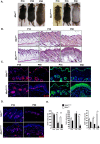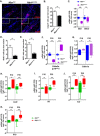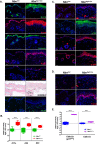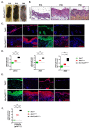Epidermal Nbn deletion causes premature hair loss and a phenotype resembling psoriasiform dermatitis
- PMID: 27050272
- PMCID: PMC5029606
- DOI: 10.18632/oncotarget.8470
Epidermal Nbn deletion causes premature hair loss and a phenotype resembling psoriasiform dermatitis
Abstract
Nijmegen Breakage Syndrome is a disease caused by NBN mutations. Here, we report a novel function of Nbn in skin homeostasis. We found that Nbn deficiency in hair follicle (HF) progenitors promoted increased DNA damage signaling, stimulating p16Ink4a up-regulation, Trp53 stabilization and cytokines secretion leading to HF-growth arrest and hair loss. At later stages, the basal keratinocytes layer exhibited also enhanced DNA damage response but in contrast to the one in HF progenitor was not associated with pro-inflammatory cytokines expression, but rather increased proliferation, lack of differentiation and immune response resembling psoriasiform dermatitis. Simultaneous Nbn and Trp53 inactivation significantly exacerbated this phenotype, due to the lack of inhibition of pro-inflammatory cytokines secretion by Trp53. Altogether, we demonstrated novel functions of Nbn in HF maintenance and prevention of skin inflammation and we provide a mechanistic explanation that links cell intrinsic DNA maintenance with large scale morphological tissue alterations.
Keywords: Gerotarget; Nbn; inflammation; psoriasiform dermatitis; skin.
Conflict of interest statement
The authors state no conflict of interest.
Figures




Similar articles
-
Loss of epidermal Evi/Wls results in a phenotype resembling psoriasiform dermatitis.J Exp Med. 2013 Aug 26;210(9):1761-77. doi: 10.1084/jem.20121871. Epub 2013 Aug 5. J Exp Med. 2013. PMID: 23918954 Free PMC article.
-
Barrier abnormality due to ceramide deficiency leads to psoriasiform inflammation in a mouse model.J Invest Dermatol. 2013 Nov;133(11):2555-2565. doi: 10.1038/jid.2013.199. Epub 2013 Apr 30. J Invest Dermatol. 2013. PMID: 23633022
-
Epidermal expression of 65 and 72 kd heat shock proteins in psoriasis and AIDS-associated psoriasiform dermatitis.J Am Acad Dermatol. 1995 Dec;33(6):985-9. doi: 10.1016/0190-9622(95)90291-0. J Am Acad Dermatol. 1995. PMID: 7490370
-
Signalling in inflammatory skin disease by AP-1 (Fos/Jun).Clin Exp Rheumatol. 2015 Jul-Aug;33(4 Suppl 92):S44-9. Epub 2015 Oct 12. Clin Exp Rheumatol. 2015. PMID: 26458100 Review.
-
Resident skin cells in psoriasis: a special look at the pathogenetic functions of keratinocytes.Clin Dermatol. 2007 Nov-Dec;25(6):581-8. doi: 10.1016/j.clindermatol.2007.08.013. Clin Dermatol. 2007. PMID: 18021896 Review.
Cited by
-
Differences in reproductive toxicology between alopecia drugs: an analysis on adverse events among female and male cases.Oncotarget. 2016 Dec 13;7(50):82074-82084. doi: 10.18632/oncotarget.12617. Oncotarget. 2016. PMID: 27738338 Free PMC article.
-
Nbs1-mediated DNA damage repair pathway regulates haematopoietic stem cell development and embryonic haematopoiesis.Cell Prolif. 2021 Mar;54(3):e12972. doi: 10.1111/cpr.12972. Epub 2021 Feb 14. Cell Prolif. 2021. PMID: 33586242 Free PMC article.
-
Replication Stress, DNA Damage, Inflammatory Cytokines and Innate Immune Response.Genes (Basel). 2020 Apr 9;11(4):409. doi: 10.3390/genes11040409. Genes (Basel). 2020. PMID: 32283785 Free PMC article. Review.
References
-
- Digweed M, Sperling K. Nijmegen breakage syndrome: clinical manifestation of defective response to DNA double-strand breaks. DNA Repair (Amst) 2004;3:1207–1217. - PubMed
-
- Rein K, Stracker TH. The MRE11 complex: an important source of stress relief. Exp Cell Res. 2014;329:162–169. - PubMed
-
- Debniak T, Gorski B, Cybulski C, Jakubowska A, Kurzawski G, Kladny J, Zaluga E, Fiedorowicz J, Debniak B, Lubinski J. Increased risk of breast cancer in relatives of malignant melanoma patients from families with strong cancer familial aggregation. Eur J Cancer Prev. 2003;12:241–245. - PubMed
MeSH terms
Substances
LinkOut - more resources
Full Text Sources
Other Literature Sources
Medical
Molecular Biology Databases
Research Materials
Miscellaneous

